![]()
![]()
![]()
Use LEFT and RIGHT arrow keys to navigate between flashcards;
Use UP and DOWN arrow keys to flip the card;
H to show hint;
A reads text to speech;
169 Cards in this Set
- Front
- Back
|
the diamond shaped area between the thighs is called the?
|
perineum
|
|
|
many structures of the reproductive system are located in the? others are located in the?
|
pelvis; perineum
|
|
|
the perineum is bordered by the
|
pubic symphysis, ischial tuberosities, and coccyx
|
|
|
urogenital triangle is located?
contains? what is opposite of this triangle? |
anterior;
contains the urethral and vaginal orifices in females and base of the scrotum in males anal triangle is posterior to urogenital triangle |
|
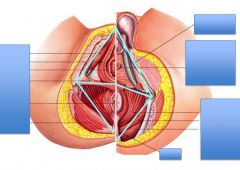
the anterior region of the perineum is called?
the posterior is called the? |

urogenital triangle
anal triangle |
|
|
sperm consist of?
where are they housed? why? |
a head capped with an acrosome
a tail packed with mitochondria housed outside of the body in the scrotum because they cannot develop normally at the high temps of the body |
|
|
how does the scrotum regulate its temperature?
|
by contracting the dartos and cremaster muscles
|
|
|
the wall of the scrotum contains what type of muscles?
|
dartos muscle
|
|
|
the cremaster muscle is part of what?
|
the spermatic cord
|
|
|
the spermatic cord contains what muscles?
|
cremaster muscles
|
|
|
semen analysis analyzes what three aspects of sperm?
|
sperm count (sperm per cc)
sperm motility (percent moving) sperm morphology |
|
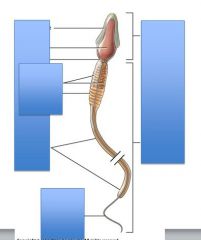
|
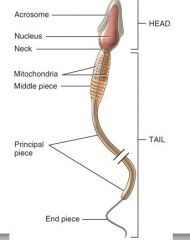
|
|
|
the testies include what 4 major parts?
|
seminiferous tubules, rete testies, efferent ducts, and epididymis
|
|

what is this?
|
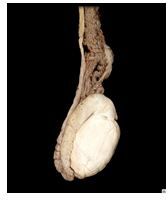
testes
|
|
|
where is the sight of spermatogenesis?
|
seminiferous tubules
|
|
|
the seminiferous tubules are packed how and into where? what occurs here?
|
hundres of highly coiled 2 foot long tubes packed into tunica al/bug/in/ea
spermatogenesis |
|
|
what collects sperm from the seminiferous tubules?
|
rete testis
|
|
|
what is the function of efferent ducts?
|
carry sperm to the epididymis
|
|
|
what is the epididymis?
|
4m coiled tube alongside the testis;
stores and matures sperm |
|
|
what stores sperm? where does sperm mature?
|
epididymis of the testies
|
|

|

|
|

what is this a picture of?
|
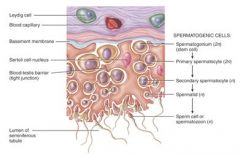
part of a seminiferous tubule
|
|
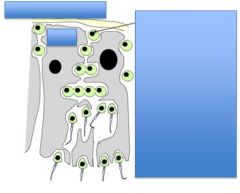
steps of spermatogenesis. how long does it take?
|
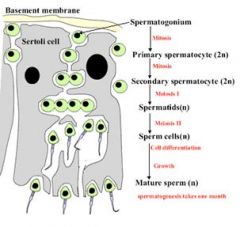
one month
|
|

|
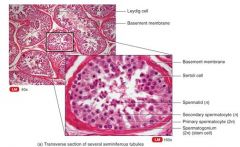
|
|
|
failure of the testes to descend is called?
|
crypto/rich/idism
|
|
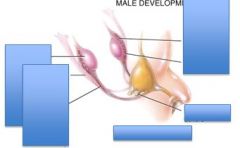
|
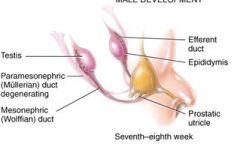
|
|

|
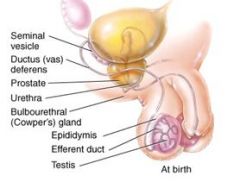
|
|
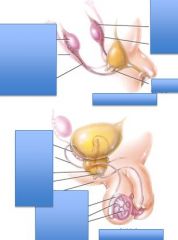
|
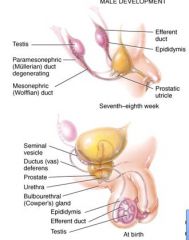
|
|
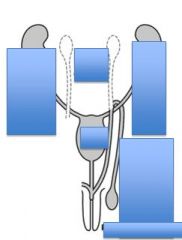
|
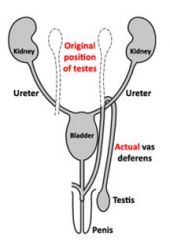
|
|
|
where does mature sperm exit? where does it enter?
|
exits the epididymis
enters the vas deferens |
|
|
spermatic cord is?
carries? |
series of muscle and fascial layers
carries vas deferens, testicular artery, and vein |
|
|
the oblique channel through the abdominal body wall is called the? what passes through this channel?
|
inguinal canal
spermatic cord |
|
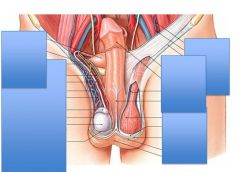
|

|
|

|
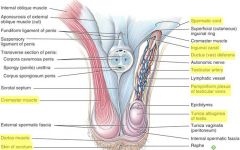
|
|
|
Where is vas deferens path? where does it extend?
|
vas deferens travels within the pelvic cavity
from the inguinal canal to the prostate gland |
|
|
how is the ejaculatory duct constucted?
|
ampulla of vas deferens + proximal region of seminal vesicle
|
|
|
ampulla of vas deferens + proximal region of seminal vesicle
|
ejaculatory duct
|
|

|

|
|
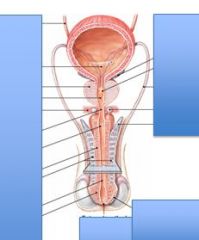
|

|
|
|
what secrete seminal fluid?
|
seminal vesicles, prostate gland, and bulbourethral glands
|
|
|
seminal vesicles, prostate gland, and bulbourethral glands secrete what?
|
seminal fluid
|
|
|
semen is made of
|
seminal fluid and sperm mixed
|
|
|
sperm + seminal fluid=
|
semen
|
|
|
seminal vesicles secrete what?
|
seminal fluid and two viscous fluids"
fructose and prostaglandins |
|
|
what does fructose do?
|
nourish sperm in the reproductive tract
|
|
|
what does prostaglandins do?
|
dilates the cervix
|
|
|
where is the seminal vesicles?
what does it join? |
posterior to the bladder
joins with vas deferens to form the ejaculatory duct |
|
|
the walnut shaped gland inferior to the bladder is called the?
|
prostate gland
|
|
|
the prostate gland secretes what? what are each for?
|
seminal fluid
citric acid for nourishment seminal plasmin --an antibiotic that combats UTIs prostate-specific antigen (PSA)--liquefies semen after ejaculations |
|
|
what gland is located in the urogenital diaphragm next to the membranous urethra?
|
Bulbourethral gland
|
|
|
what is another name for bulbourethral gland?
|
cowper's gland
|
|
|
where does the bulbourethral gland project into?
|
the base of the penis and enters the spongy urethra
|
|
|
the bulbourethral gland secretes what? what is the function?
|
seminal fluid
mucin-protects urethra and serves as lunricant during sex |
|
|
semen is a mixture of what? primarily what?
|
alkaline mixture of sperm and glandular secrectionss
the volume is largely due to seminal fluid |
|
|
why is semen alkaline?
|
to protect sperm from the acidic secretions of the vagina
|
|
|
semen is given a specific name during a specific time?
|
when released during intercourse
semen is called the ejaculate |
|
|
how much is each ejaculate? contains what?
|
3-5mL
200-500 million spermatozoa |
|
|
average amount of time from seminiferous tubule to ejaculate? how long can it be retained? what happens after this time?
|
2 weeks.
6mos before resorption |
|

what is this? what are its different parts? what does it do?
|
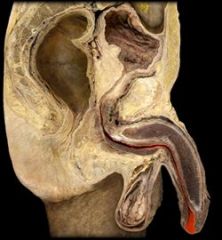
urethra.
prostatic, membranous, spongy urethra transports semen from ejaculatory duct |
|
|
what is the penis composed of?
|
three primary erectile tissue bodies
|
|
|
what are the three primary erectile tissue bodies?
|
corpus cavernosum
corpus spongiosum prepuce |
|
|
what is the cavernosum? where does it end?
|
paired masses on the anterior surface of the flaccid penis
ends in a crus internally |
|
|
what is the surface of the flaccid penis called?
|
the body
|
|
|
corpus spongiosum is what and where?
indernally forms what? its expanded distal end is called what? what does this distal end contain? |
single mass surrounding the urethra on the posterior side of the flaccid penis
internally forms the bulb glans containing external urethral orifice |
|
|
the prepuce is also known as
|
foreskin
|
|

|

|
|
|
corpus spongiosum contains what muscle?
corpus cavernosa contains what muscle? these muscles of the ______ do what? |
bulbospongiosus
ischiocavernosus muscles of the penis that expell semen |
|

what is this? what is the purpose?
|
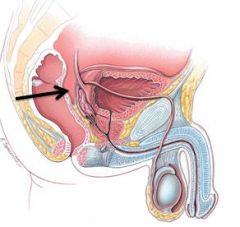
The rectovesical pouch is a potential space formed between the rectum and bladder/seminal vesicles
|
|
|
The female reproductive system is collectively called?
what are the 6 parts? |
vulva;
mons pubis, labia majora, labia minora, clitoris, prepuce, vestibule |
|
|
what is the mons pubis?
|
expanse of skin and subcutaneous tissue anterior to the pubic symphysis
|
|
|
what is the labia majora
|
paired, thickened folds of skin, sebaceous glands, and CT
|
|
|
what is labia minora
|
paired, highly vascular folds with sebaceous glands and melanocytes
|
|
|
what is the clitoris?
body is composed of? contains? |
small erectile body anterior to labia minora
paired crura (crus singular) body composed of corpus cavernosum glans of corpus spongiosum |
|
|
what is prepuce?
|
fold of labia minora covering the clitorus
|
|
|
what is the vestibule? what does it contain?
|
potential space between labia minora
urethral opening and vaginal orifice bulbs of the vestibule and greater vestibular glands |
|
|
internal structures of the vulva include?
|
clitoris and bulb of vestibule
|
|
|
the bulb of vestibule composed of?
located where? form what? covered by what? |
paired structures composed of corpus spongiosum
deep to the labia and form the internal walls of the vestibule covered by the same muscles of the male |
|

|
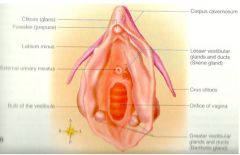
|
|
|
what are the paired sex organs of females? what happens here?
anchored to the ______ via_____ which is a _______ anchored to the ______ via________ |
ovaries; site of oocyte development
anchored to the body wall via broad ligament which is a sheet of peritoneum anchored to the uterus via ovarian ligament |
|
|
the uterine tubes are also known as?
project from the ____ with _______ |
fallopian tubes
which project from the uterus with infundibulum |
|
|
what is the infundibulum?
what projects from it? |
-an opening at the distal end of the uterine tubes
-long folds called fimbriae |
|
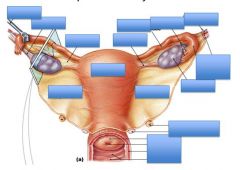
|

|
|
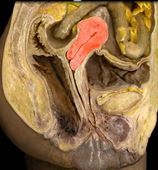
what is this?
how is it described? anchored anteriorly by? subdivided into what? |

the uterus;
pear shaped and muscular organ anchored anteriorly by round ligament of the uterus subdivided into the fundus, body, cervix, and cervical os |
|
|
what is the fundus
|
anterosuperior end of the uterus
|
|
|
what is the uterine body?
|
the long, narrowing portion of the uterus leading to the cervix
|
|
|
the cervix is what?
contains what? |
the inferior neck of the uterus projecting into the vagina
contains the cervical os |
|
|
what is the cervical os?
|
the opening to the vagina
|
|

|
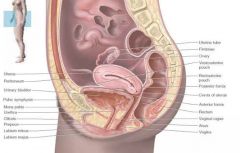
|
|

|

|
|
|
the uterus has three layers, what are they?
|
perimetrium, myometrium, and endometrium
|
|
|
what is the perimetrium
|
peritoneum and underlying CT continuous with broad ligament
|
|
|
what is myometrium
|
thick layer of smooth muscle
|
|
|
what is endometrium
|
simple columnar epithelium with underlying CT
|
|

|

|
|

what is this? what is it composed of? lined by?
where is it located? what does it open up into? |
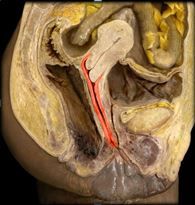
vagina; elastic tube with SM in wall lined by stratified squamous epithelium
located btwn urinary bladder (anterior) and rectum (posterior) opens into the vestibule |
|
|
projection of cervix into vagina creates what?
|
anterior and posterior fornix
|
|
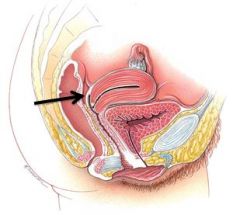
what is this? which is?
|
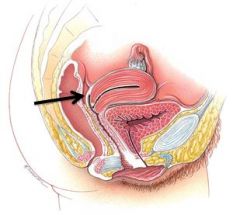
The rectouterine pouch is a potential space formed between the rectum and uterus
|
|
|
what are mammary glands?
|
Compound tubuloalveolar exocrine gland located within the anterior thoracic wall
|
|
|
mammory glands are divided into _____ separated by ____ and supported by the _______;
located near ___________ducts and sinuses |
lobes;
adipose tissue; suspensory ligaments; lactiferous ducts and lactiferous sinuses |
|
|
function of lactiferous ducts?
|
drains milk from tissue of each lobe
|
|
|
what are lactiferous sinuses?
|
expanded end of lactiferous ducts near the nipple
|
|
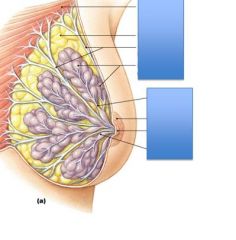
|
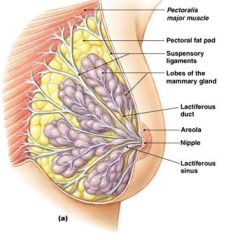
|
|

what is this?
|
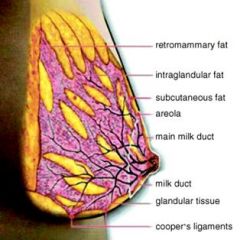
Drawing of the gross anatomy of the lactating breast based on ultrasound observations made of the milk duct system and distribution of different tissues within the breast.
|
|
|
smaller lactiferous ducts converge into what? arranged how?
|
about 10 main milk ducts arranged in a complex overlapping structure
|
|
|
milk exits breast thru
|
tiny holes in the nipple
|
|
|
the nipple is a _______ surrounded by the pigmented structure ______
|
raised structure surrounded by the pigmented areola
sinuses probably do not exist |
|
|
male and female fetuses are the same until _________ when genetalia develop from a series of ________.
|
about 6 weeks.
genital folds |
|
|
at 6 weeks, release of _____ causes _______ to develop.
external genitalia begin to develop around ______weeks |
TDF. testes. 9.
|
|
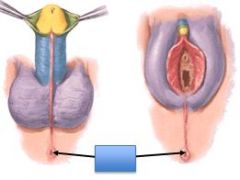
what are the 5 major homologies?
|
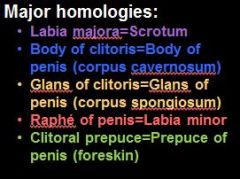
box was the anus!!!
|
|
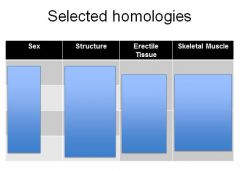
|
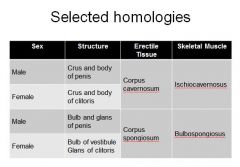
|
|
|
Nonpregnant females exhibit a series of _________________ that affect the __________.
Each cycle takes about ___________ |
cyclical changes in hormone levels;
ovaries and uterus; a month (~28 days). |
|
|
non pregnant women have how many cycles? what are they?
|
two concurrent cycles;
ovarian and uterine cycles |
|
|
the ovarian cycle is?
|
a series of changes in ovaries leading up to and following ovulation
|
|
|
the uterine cycle is? aka?
|
a series of changes in the endometrial layer of the uterus in preparation for a fertilized ovum
aka menstral cycle |
|
|
The ovaries consist of what 3 major parts?
|
tunica albuginea
primordial follicles primary follicles secondary follicles mature follicles |
|
|
tunica albuginea is what?
|
one of outer layers surrounding the ovary
|
|
|
primordial follicles are?
found near what? what stage? |
primary oocyte surrounded by a single layer of flat follicular cells
found near outer surface of ovary smallest stage |
|
|
primary follicles are?
surrounded by? encased in a dark coating called? |
primary oocytes
surrounded by many small granulosa cells encased in zona pellucida |
|
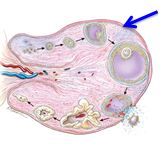
|
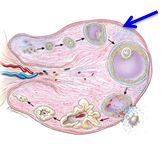
tunica albuginea
|
|

|

primary oocyte surrounded by single layer of flat follicular cells
|
|

|
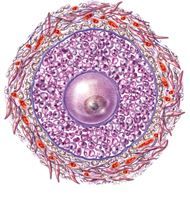
primary oocytes surrounded by many, small granulosa cells and encased in a dark coating called the zona pellucida
|
|
|
how is a secondary follicle formed?
|
granulosa cells secrete fluid creating an antrum around primary oocyte
|
|
|
what is a mature follicle? aka?
what happens to the primary oocyte? what surrounds the oocyte? what does this adhere to? |
largest and final stage formed just before ovulation;
aka Graafian follicle; primary oocyte develops into a haploid secondary oocyte; layer of cells called corona radiata surround oocyte and adheres to the zona pellucida |
|
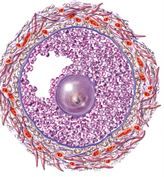
what is this? what is the space called? how is it formed?
|

secondary follicle
antrum granulosa cells secrete a fluid to create it |
|

what is this?
|
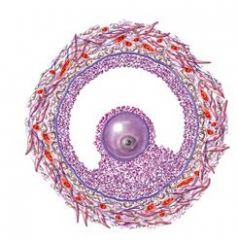
mature follicle with haplid secondary oocyte
corona radiata zona pellucida |
|
|
at any given time, what will be found within a histological section of an ovary?
|
multiple stages of oocyte development/ovarian cycle
|
|
|
at puberty, the hypothalamus releases what in females? which stimulates what?
|
GnRH (gonadotropin releasing hormone)
stimulating the anterior pituitary to release FSH and LH |
|
|
what hormones does the anterior pituitary release?
in response to what? |
FSH (follicle stimulating hormone)
LH (luteinizing hormone) in response to GnRH (gonadotropin releaseing hormone) |
|
|
what does the release of FSH and LH cause?
|
primary follicles to mature into secondary follicles
|
|
|
monthly ovarian cycle is caused by what?
|
cyclical variation in FSH and LH levels
|
|

|

|
|
|
What are the Three components of the ovarian cycle?
what are the days associated with each component and what happens during each stage |

|
|
|
ovulation occurs when?
|
day 14
|
|
|
describe ovulation:
|

|
|

|

|
|
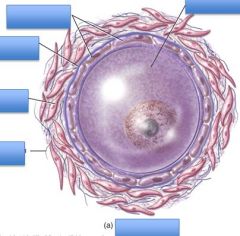
|

|
|
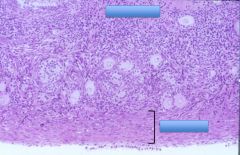
|

primordial follicle
|
|
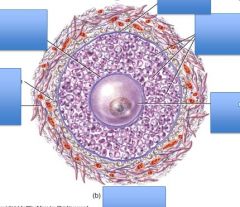
|
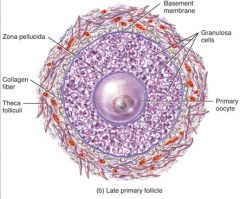
|
|

|

primary follicle
|
|

|
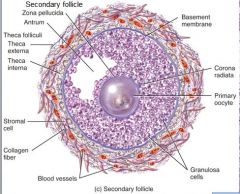
secondary follicle
|
|

|
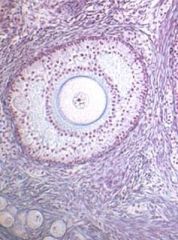
secondary follicle
|
|

|

mature follicle
|
|
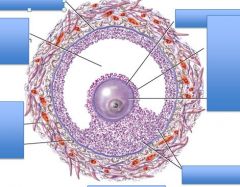
|

|
|
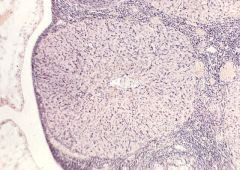
|
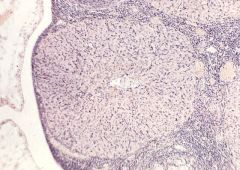
corpus luteum
|
|

|
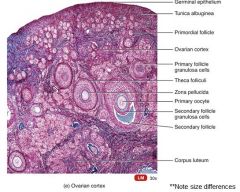
|
|
|
The Uterus has three major layers
|
perimetrium
myometrium endometrium |
|
|
endometrium of the uterus has two parts that develop differently during the uterine phase
|
stratum functionalis
stratum basalis |
|
|
stratum functionalis lines what?
built ip when? sheds when? |
lines the uterine cavity
is bulit up during the proliferative phase shed during menstration |
|
|
outer surface of stratum functionalis is made up of what?
becomes highly _____________ contains what? |
simple columnar epithelium
vascularized special endometrial glands |
|
|
stratum basalis is what?
function? |
permanent layer of cells
replaces stratum functionalis after each menstration |
|
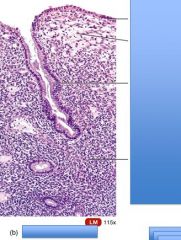
|
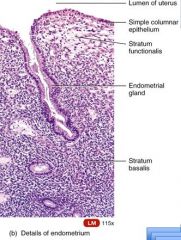
|
|
|
day one of the uterine cycle consists of?
|
menstrual phase
|
|
|
what happens during the menstral phase?
|
previous lining of endometrium is discharged through the vagina
|
|
|
what are the three phases of the uterine cycle?
|
menstrual phase
proliferative/preovulatory phase secretory/postovulatory phase |
|
|
the proliferative /preovulatory phase is stimulated by what?
|
estrogen begins rebuilding of endometrium
|
|
|
secretory/postovulatory phase is stimulated by what?
|
progesterone and estrogen promotes vascularization and thickening of endometrium
|
|

|

|
|

|
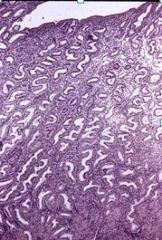
endometrium during secretory phase
|
|
|
Thus the ontogeny for maleness is a complex and precarious process – a continuing struggle against the basic trend toward femaleness – Imperato-McGinley and Peterson
|
Thus the ontogeny for maleness is a complex and precarious process – a continuing struggle against the basic trend toward femaleness – Imperato-McGinley and Peterson
|
|
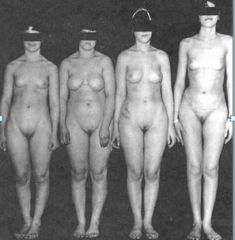
|

androgen insensitivity syndrome
|
|
|
androgen insensitivity syndrome
|
-Genetic sex: XY
- Phenotypic/Psychosocial sex: Female - Normal to high testosterone circulates, but cannot bind to cytoplasmic receptors – hence ‘insensitive’ to testosterone during development |
|
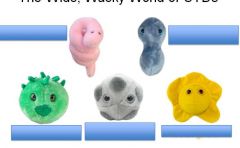
|
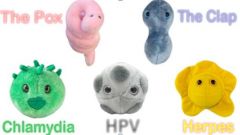
|
|
|
syphilis aka
|
the pox
|
|

|
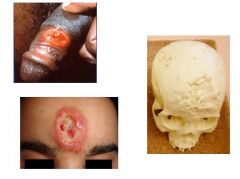
syphilis
|
|
|
HPV
|
human papilloma virus
get warts |
|
|
herpes
|
lesions found on shaft of penis
vagina, vulva, or cervix anus |
|
|
chlamydia
|
get that everywhere
|
|
|
gonorrhea
|
the clap
slammed books on penis to get rid of discharge hahaha |
|
|
HIV AIDS
|
see pf 570-571 in book
|

